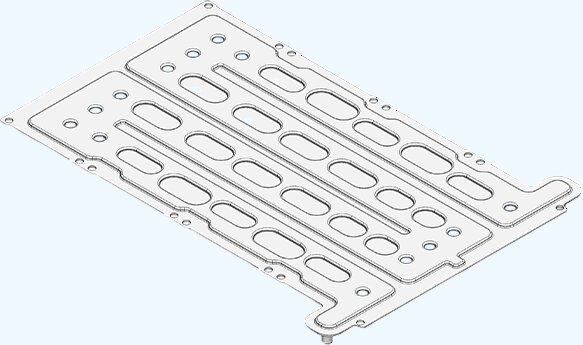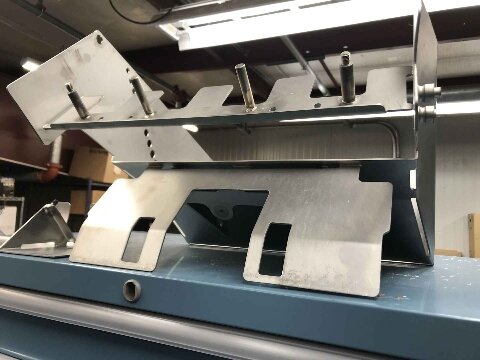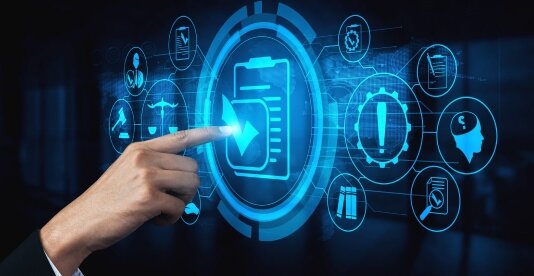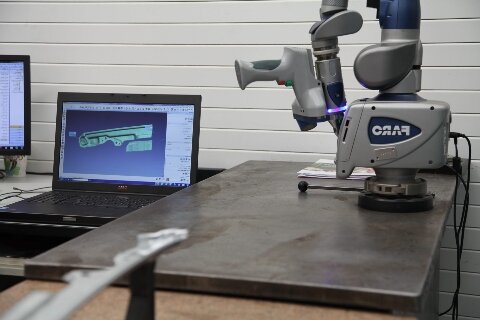銅はその優れた電気伝導性と熱伝導性から、長い間製造業において重要な素材でした。3D プリント技術の台頭により、メーカーは銅の特性を活かして複雑で高性能な部品を作ることができるようになりました。このガイドでは、銅の 3D プリントの基礎、利点、応用について説明します。
銅 3D プリントとは何ですか?
銅の3Dプリンティングは積層造形で、銅の粉末やワイヤーを重ねて溶かし、部品を作ります。銅は反射率が高く、熱伝導率が高いため、鋳造や機械加工のような従来の方法ではうまくいきません。
レーザーと押し出しベースの 3D プリントにおける最近の進歩が、この状況を変えました。今では製造業者は銅の詳細なパーツを高い精度と効率で作ることができます。
銅3Dプリンティングの仕組み
銅の3Dプリンティングは、積層造形を使用してデジタルデザインを物理的な部品に変換します。ここでは、その仕組みを順を追って説明します。
3Dモデルの設計
CADソフトウェアを使用して作成したデジタル3Dモデルから始めます。このモデルが部品の形状、サイズ、特徴を定義します。
ファイルの準備
3Dモデルは、専用のソフトウェアを使って薄いレイヤーにスライスされる。これにより、3Dプリンターが読み込んで実行できるファイルが作成される。
プリンタのセットアップ
銅粉またはワイヤーを3Dプリンターにセットします。ビルドプラットフォームが清潔で、正確なプリントのために正しくキャリブレーションされていることを確認します。
部品を印刷する
プリンターは銅素材を層ごとに堆積させたり溶かしたりします。選択的レーザー溶融(SLM)のような技術では、レーザーを使って粉末を溶かしますが、直接エネルギー蒸着(DED)ではワイヤーや粉末を蒸着しながら溶かします。
後処理
印刷後、部品は熱処理、研磨、機械加工などの追加工程を経て、望ましい仕上げと特性を得ることができる。
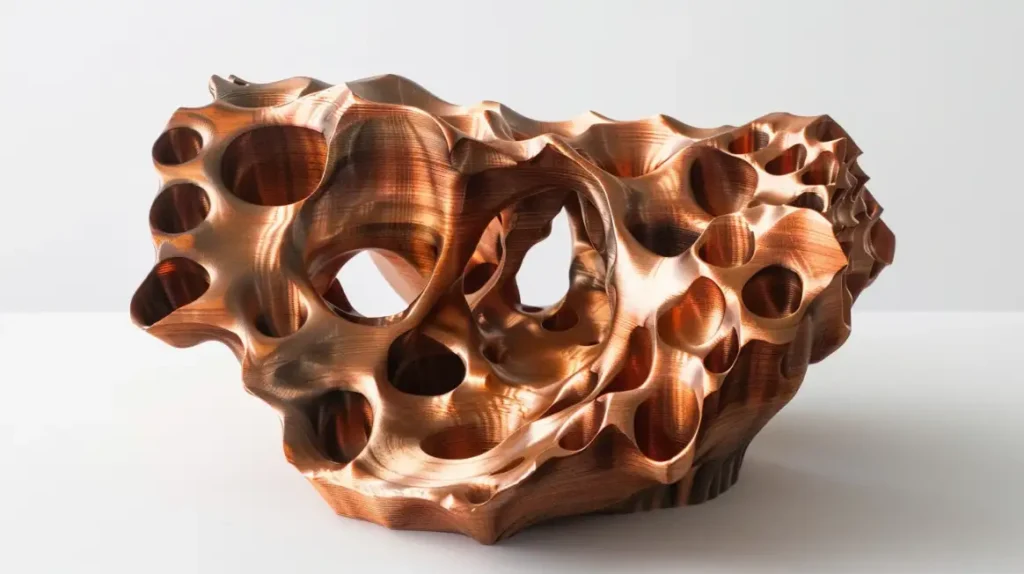
3Dプリント銅の特性
3D プリントされた銅の部品は、従来から製造されている銅とは異なる特性を示しています:
熱伝導率
銅の優れた熱伝導率は、熱管理用途で重宝されます。3D プリントされた銅の熱伝導率は、プリント技術やパラメータにもよりますが、一般的に錬銅の 85~95% に達します。
電気伝導性
導電性は多くの銅の用途にとって重要な特性です。現在の 3D プリント技術で実現できること
- DMLS: 80-90% IACS (国際アニール銅規格)
- EBM: 85-95% IACS
- BMD:75-85% IACS
機械的性質
3D プリントされた銅の機械的特性は、気孔率、造形方向、後処理に大きく左右されます:
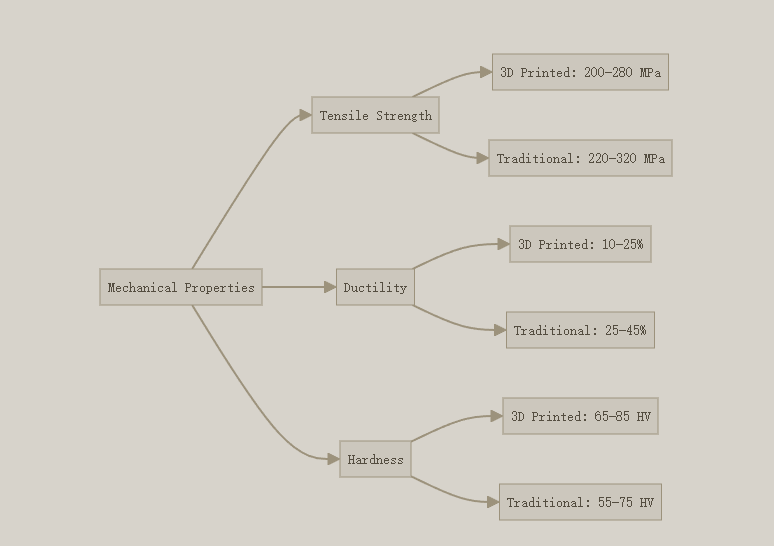
現在の銅3Dプリンティング技術
いくつかの 3D プリント技術は銅と互換性があります。それぞれの方法には独自の利点があり、特定の用途に適しています。
直接金属レーザー焼結(DMLS)
DMLSは高出力レーザーで銅粉を溶かす。レーザーは3Dモデルに基づいて各層の形状を追従する。各レイヤーが終わると、ビルド・プラットフォームが下がり、新しい粉末の層が表面に広がります。
DMLS は高精度(±0.1mm)で、99.5% の密度のパーツを作ることができます。DMLSは高精度(±1mm)で、99.5%の密度のパーツを作ることができます。新しい緑と青のレーザーがこの問題を解決してくれました。
電子ビーム溶解(EBM)
EBMはレーザーの代わりに電子ビームを使って銅粉を溶かす。このプロセスは真空中で行われ、銅が酸化するのを防ぐ。
電子ビームはレーザーよりもエネルギー効率が高く、印刷部品のストレスを軽減します。そのため、銅の印刷にありがちな反りや歪みの可能性が低くなります。
バウンドメタルデポジション(BMD)
BMDは、ポリマーバインダーと混合した銅粒子を使用します。材料は FDM 印刷のようにノズルから押し出されます。印刷後、部品はポリマーを取り除くために脱バインダー工程を経て、銅粒子を融合させるために焼結します。
BMDにはいくつかの利点がある。この装置は安価で使いやすく、金属粉がばらばらにならないので安全である。しかし、部品は焼結中に15-20%収縮するため、設計プロセスで考慮する必要がある。
バインダージェッティング
バインダージェッティングは、液体バインダを銅粉のベッドにスプレーすることで機能する。プリントヘッドが表面を移動し、必要なところにバインダーを加える。各層の後、プラットフォームが下がり、新しいパウダーの層が広がります。
グリーン」部品と呼ばれる印刷部品は、銅を融合させるために焼結を受けなければならない。この方法はレーザーや電子ビーム印刷よりも速く、複数の部品を同時に作ることができる。
| テクノロジー | 決議 | 材料密度 | 表面仕上げ | 料金 | スピード | 複雑性能力 |
|---|---|---|---|---|---|---|
| DMLS | 高い(±0.05mm) | 97-99% | グッド | 高い | 適度 | 素晴らしい |
| EBM | ミディアム(±0.1mm) | >99.5% | 公平 | 非常に高い | 速い | 非常に良い |
| BMD | ミディアム(±0.1mm) | 95-98% | 公平 | 適度 | 遅い | グッド |
| バインダージェッティング | ミディアム(±0.1mm) | 92-97% | 公平 | 適度 | とても早い | グッド |
銅3Dプリンティングの用途
銅の3Dプリンティングは、これまで製造が困難であった、あるいは不可能であった部品の製造を可能にすることで、産業に変革をもたらしつつあります。以下はその主な用途です:
| 産業 | 申し込み | 利点 |
|---|---|---|
| エレクトロニクス | 回路基板、コネクター、アンテナ | 高い導電性と設計の柔軟性。 |
| 航空宇宙 | 熱交換器と冷却システム | 軽量、複雑な形状、効率的な熱管理。 |
| 医学 | 抗菌インプラントおよび器具 | 耐食性と生体適合性。 |
| 自動車 | 電気自動車部品 | 熱管理の改善と軽量化。 |
| エネルギー | ヒートシンクとソーラーパネル部品 | 熱伝導性と耐久性が向上。 |
銅3Dプリンティングの利点
銅の3Dプリントにはいくつかの利点があり、エンジニア、デザイナー、製造業者にとって貴重なツールとなっています。ここでは、その主な利点について詳しく見ていきましょう。
デザインの自由
3Dプリンティングは、従来の方法では実現できなかった複雑な形状を可能にします。複雑な内部構造、軽量設計、特定のニーズに合わせたカスタム形状を作成できます。この柔軟性が、イノベーションの新たな可能性を切り開く。
材料効率
積層造形では、部品を作るのに必要な材料のみを使用するため、廃棄物が削減される。余分な材料を削り取る減法的な方法とは異なり、3Dプリントは材料を層ごとに追加するため、より持続可能な選択肢となります。
コスト削減
最初のセットアップには費用がかかるが、3Dプリンティングは長期的にはコスト削減につながることが多い。特に以下のような場合、高価な金型が不要になる。 プロトタイプ そして 少量生産.また、設計から生産までのサイクルもスピードアップする。
パフォーマンス
銅の優れた熱伝導性と電気伝導性は、3D プリントしたパーツの性能を高めます。熱交換器であれ、電気部品であれ、カスタムツールであれ、銅の3Dプリントは耐久性があり、高性能な結果をもたらします。
課題と考察
銅の3Dプリンティングには多くの利点がありますが、同時にユニークな課題もあります。それを理解することで、プロジェクトを計画し、最適化することができます。
高反射率
銅は反射しやすい性質があるため、レーザーが粉末を安定して溶かすことが難しい。このため、溶融にムラが生じ、最終部品の品質に影響を及ぼす可能性があります。この問題を克服するには、特殊な装置と正確なレーザー設定がしばしば必要となります。
熱伝導率
銅の熱伝導率の高さは、利点でもあり課題でもあります。熱管理には最適ですが、それは同時に、印刷中に熱が素早く放散することを意味し、適切なレイヤー融合のために適切な温度を維持することが難しくなります。
酸化
銅は空気に触れるとすぐに酸化し、部品の強度を弱め、表面品質に影響を与えます。アルゴンや窒素のような不活性ガス環境での印刷は、酸化を防ぎ、より良い結果を保証します。
後処理の要件
銅の部品は印刷後、次のような追加工程が必要になることがよくあります。 熱処理, 研磨または機械加工。これらの工程は、部品の強度、表面仕上げ、全体的な品質を向上させるが、生産サイクルに時間とコストを追加する。
結論
銅の3Dプリンティングは、より自由な設計と優れた性能を可能にすることで、製造業を変えました。まだ課題はありますが、新しい技術によって、より多くの用途で実用的なプロセスになりつつあります。
Shengenでは、完全な製造ソリューションを提供することに専念しています。銅3Dプリンティングのような先進技術と板金加工の専門知識を組み合わせ、お客様のニーズにお応えします。
銅の3Dプリントの利点を活用したいのであれば、私たちがお手伝いします。 お問い合わせ お客様のニーズをお聞かせいただき、私たちがどのように精密かつ効率的にお客様のデザインに命を吹き込むことができるかをご確認ください。
よくある質問銅の3Dプリンティング
3Dプリント銅と従来の銅製造のコストの違いは何ですか?
3D プリントされた銅の単位体積あたりのコストは、従来製造された銅の 3~5 倍になるのが普通です。しかしこのコスト差は、複雑な形状の場合、従来の製造では複数の作業や組み立て工程が必要であったものが、大幅に減少します。
3Dプリントされた銅の部品で可能な最大のサイズは?
現在市販されているシステムでは、250×250×250mmから500×500×500mmまでの製造が可能である。複数のプリントセクションを接合することで、より大きなパーツを作ることも可能です。
3Dプリントされた銅の導電性は、従来の銅と比べてどうなのでしょうか?
ほとんどの 3D プリント銅は、プリント技術やパラメータ、後処理にもよりますが、錬銅の 80 ~ 95% の導電率を達成しています。
3D プリント銅は高温の用途に使えるのか?
そうです。3Dプリント銅は高温でも優れた特性を維持し、特定の合金や製造方法にもよりますが、最高800℃の用途に適しています。
3D プリントされた銅には、通常どのような後処理が必要ですか?
一般的な後処理には、内部応力を緩和するための熱処理、気孔率を低減するための熱間静水圧プレス、導電性を向上させるための表面仕上げ、重要な寸法や特徴のための機械加工などがある。

ケビン・リー
レーザー切断、曲げ加工、溶接、表面処理技術を専門とし、板金加工において10年以上の実務経験があります。シェンゲンのテクニカルディレクターとして、複雑な製造上の課題を解決し、各プロジェクトにおける革新と品質の向上に尽力しています。

